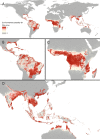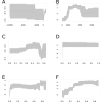Mapping global environmental suitability for Zika virus - PubMed (original) (raw)
doi: 10.7554/eLife.15272.
Moritz Ug Kraemer 1, Oliver J Brady 2, David M Pigott 2 3, Freya M Shearer 2, Daniel J Weiss 1, Nick Golding 4, Corrine W Ruktanonchai 5, Peter W Gething 1, Emily Cohn 6, John S Brownstein 6, Kamran Khan 7 8, Andrew J Tatem 5 9, Thomas Jaenisch 10 11, Christopher Jl Murray 3, Fatima Marinho 12, Thomas W Scott 13, Simon I Hay 2 3
Affiliations
- PMID: 27090089
- PMCID: PMC4889326
- DOI: 10.7554/eLife.15272
Mapping global environmental suitability for Zika virus
Jane P Messina et al. Elife. 2016.
Abstract
Zika virus was discovered in Uganda in 1947 and is transmitted by Aedes mosquitoes, which also act as vectors for dengue and chikungunya viruses throughout much of the tropical world. In 2007, an outbreak in the Federated States of Micronesia sparked public health concern. In 2013, the virus began to spread across other parts of Oceania and in 2015, a large outbreak in Latin America began in Brazil. Possible associations with microcephaly and Guillain-Barré syndrome observed in this outbreak have raised concerns about continued global spread of Zika virus, prompting its declaration as a Public Health Emergency of International Concern by the World Health Organization. We conducted species distribution modelling to map environmental suitability for Zika. We show a large portion of tropical and sub-tropical regions globally have suitable environmental conditions with over 2.17 billion people inhabiting these areas.
Keywords: Zika virus; disease mapping; epidemiology; global health; human; infectious disease; microbiology; vector-borne disease; virus.
Conflict of interest statement
SIH: Reviewing editor, eLife.
The other authors declare that no competing interests exist.
Figures
Figure 1.. (A) Map showing the distribution of the final set of 323 ZIKV occurrence locations entered into the ensemble Boosted Regression Tree modelling procedure.
Locations are classified by year of occurrence to show those which took place (i) prior to the 2007 outbreak in Federated States of Micronesia; (ii) between 2007–2014; and (iii) during the 2015–2016 outbreak; (B) the total number of locations reporting symptomatic ZIKV occurrence in humans globally over time. DOI:
http://dx.doi.org/10.7554/eLife.15272.003
Figure 1—figure supplement 1.. Maps of all covariates entered into the 300 BRT models.
(A) probability of being urban, 2015; (B) enhanced vegetation index; (C) minimum relative humidity; (D) cumulative annual precipitation (mm); (E) temperature suitability for dengue via Ae. aegypti; (F) temperature suitability for dengue via Ae. albopictus DOI:
http://dx.doi.org/10.7554/eLife.15272.004
Figure 2.. Maps of (A) global environmental suitability for ZIKV, ranging from 0 (grey) to 1 (red), showing greater detail for (B) the Americas, (C) Africa, and (D) Asia and Oceania.
DOI:
http://dx.doi.org/10.7554/eLife.15272.005
Figure 2—figure supplement 1.. Uncertainty around Zika suitability predictions displayed in main manuscript – Figure 2, ranging from less than 0.01 (very little uncertainty) to 0.94 (greatest uncertainty).
DOI:
http://dx.doi.org/10.7554/eLife.15272.006
Figure 2—figure supplement 2.. Effect plots for each covariate entered into the ensemble of 300 BRT models.
(A) minimum relative humidity; (B) cumulative annual precipitation (mm); (C) enhanced vegetation index; (B) probability of being urban (%); (E) temperature suitability for dengue via Ae. aegypti; (F) temperature suitability for dengue via Ae. albopictus. DOI:
http://dx.doi.org/10.7554/eLife.15272.007
Figure 2—figure supplement 3.. Environmental suitability for Zika virus transmission to humans, not taking into account temperature suitability for dengue via Aedes albopictus.
Covariate effects are as follows: cumulative annual precipitation (67.4%); temperature suitability for dengue via Ae. aegypti (16.9%); probability of being urban, 2015 (8.2%); enhanced vegetation index (5.1%); minimum relative humidity (2.4%). DOI:
http://dx.doi.org/10.7554/eLife.15272.008
Figure 2—figure supplement 4.. Map showing areas predicted to have greater dengue suitability (from Bhatt et al., 2013, Nature) vs those which are predicted to have greater Zika suitability in the current study.
These values are restricted to areas where both diseases had non-zero predictions. DOI:
http://dx.doi.org/10.7554/eLife.15272.009
Figure 3.. Status of ZIKV reporting as of 2016 by country, showing countries that are highly environmentally suitable (having a suitable area of more than 10,000 square kilometres) but which have not yet reported symptomatic cases of ZIKV in humans. 'Currently reporting' countries are those having reported cases since 2015.
DOI:
http://dx.doi.org/10.7554/eLife.15272.010
Similar articles
- The Convergence of a Virus, Mosquitoes, and Human Travel in Globalizing the Zika Epidemic.
Imperato PJ. Imperato PJ. J Community Health. 2016 Jun;41(3):674-9. doi: 10.1007/s10900-016-0177-7. J Community Health. 2016. PMID: 26969497 Review. - The Zika outbreak of the 21st century.
Chang C, Ortiz K, Ansari A, Gershwin ME. Chang C, et al. J Autoimmun. 2016 Apr;68:1-13. doi: 10.1016/j.jaut.2016.02.006. Epub 2016 Feb 28. J Autoimmun. 2016. PMID: 26925496 Free PMC article. - The global spread of Zika virus: is public and media concern justified in regions currently unaffected?
Gyawali N, Bradbury RS, Taylor-Robinson AW. Gyawali N, et al. Infect Dis Poverty. 2016 Apr 19;5:37. doi: 10.1186/s40249-016-0132-y. Infect Dis Poverty. 2016. PMID: 27093860 Free PMC article. - Zika Virus Mosquito Vectors: Competence, Biology, and Vector Control.
Kauffman EB, Kramer LD. Kauffman EB, et al. J Infect Dis. 2017 Dec 16;216(suppl_10):S976-S990. doi: 10.1093/infdis/jix405. J Infect Dis. 2017. PMID: 29267910 Free PMC article. Review. - Zika virus: history of a newly emerging arbovirus.
Wikan N, Smith DR. Wikan N, et al. Lancet Infect Dis. 2016 Jul;16(7):e119-e126. doi: 10.1016/S1473-3099(16)30010-X. Epub 2016 Jun 6. Lancet Infect Dis. 2016. PMID: 27282424 Review.
Cited by
- Mapping Thermal Physiology of Vector-Borne Diseases in a Changing Climate: Shifts in Geographic and Demographic Risk of Suitability.
Ryan SJ. Ryan SJ. Curr Environ Health Rep. 2020 Dec;7(4):415-423. doi: 10.1007/s40572-020-00290-5. Curr Environ Health Rep. 2020. PMID: 32902817 Free PMC article. Review. - Potential for Zika virus introduction and transmission in resource-limited countries in Africa and the Asia-Pacific region: a modelling study.
Bogoch II, Brady OJ, Kraemer MUG, German M, Creatore MI, Brent S, Watts AG, Hay SI, Kulkarni MA, Brownstein JS, Khan K. Bogoch II, et al. Lancet Infect Dis. 2016 Nov;16(11):1237-1245. doi: 10.1016/S1473-3099(16)30270-5. Epub 2016 Sep 1. Lancet Infect Dis. 2016. PMID: 27593584 Free PMC article. - Climate Change and the Neglected Tropical Diseases.
Booth M. Booth M. Adv Parasitol. 2018;100:39-126. doi: 10.1016/bs.apar.2018.02.001. Epub 2018 Mar 28. Adv Parasitol. 2018. PMID: 29753342 Free PMC article. Review. - Spatial Associations Between Land Use and Infectious Disease: Zika Virus in Colombia.
Weinstein JS, Leslie TF, von Fricken ME. Weinstein JS, et al. Int J Environ Res Public Health. 2020 Feb 11;17(4):1127. doi: 10.3390/ijerph17041127. Int J Environ Res Public Health. 2020. PMID: 32053906 Free PMC article. - Epidemiological Characteristics and Regional Risk Prediction of Hemorrhagic Fever with Renal Syndrome in Shandong Province, China.
She K, Li C, Qi C, Liu T, Jia Y, Zhu Y, Liu L, Wang Z, Zhang Y, Li X. She K, et al. Int J Environ Res Public Health. 2021 Aug 11;18(16):8495. doi: 10.3390/ijerph18168495. Int J Environ Res Public Health. 2021. PMID: 34444244 Free PMC article.
References
- Arino O, Bicheron P, Achard F, Latham J, Witt R, Weber JL. GLOBCOVER the most detailed portrait of earth. ESA Bulletin. 2008:24–31.
- Barbet-Massin M, Jiguet F, Albert CH, Thuiller W. Selecting pseudo-absences for species distribution models: How, where and how many? Methods in Ecology and Evolution. 2012;3:327–338. doi: 10.1111/j.2041-210X.2011.00172.x. - DOI
- Barrera R, Amador M, Clark GG. Use of the pupal survey technique for measuring Aedes aegypti (Diptera: Culicidae) productivity in Puerto Rico. The American Journal of Tropical Medicine and Hygiene. 2006;74:290–302. - PubMed
- Becker JJ, Sandwell DT, Smith WHF, Braud J, Binder B, Depner J, Fabre D, Factor J, Ingalls S, Kim S-H, Ladner R, Marks K, Nelson S, Pharaoh A, Trimmer R, Von Rosenberg J, Wallace G, Weatherall P. Global bathymetry and elevation data at 30 arc seconds resolution: Srtm30_plus. Marine Geodesy. 2009;32:355–371. doi: 10.1080/01490410903297766. - DOI
Publication types
MeSH terms
LinkOut - more resources
Full Text Sources
Other Literature Sources
Medical







